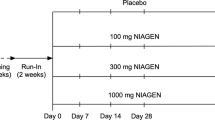Abstract
The bioavailability and urinary excretion of three dietary flavonoids, quercetin, hesperetin and naringenin, were investigated. Ten healthy men were asked to consume a ‘juice mix’ containing equal amounts of the three flavonoids, and their urine and plasma samples were collected. The resulting mean plasma area under the curve (AUC)0−48h and Cmax values for quercetin and hesperetin were similar, whereas the AUC0−48h of naringenin and, thus, the relative bioavailability were higher after consumption of the same dose. The study consolidates a significantly lower urinary excretion of quercetin (1.5±1%) compared with hesperetin (14.2±9.1%) and naringenin (22.6±11.5%) and shows that this is not due to a lower bioavailability of quercetin, but rather reflects different clearance mechanisms.
This is a preview of subscription content, access via your institution
Access options
Subscribe to this journal
Receive 12 print issues and online access
$259.00 per year
only $21.58 per issue
Buy this article
- Purchase on Springer Link
- Instant access to full article PDF
Prices may be subject to local taxes which are calculated during checkout

Similar content being viewed by others
References
Arts ICW, Sesink ALA, Faassen-Peters M, Hollman PC (2004). The type of sugar moiety is a major determinant of the small intestinal uptake and subsequent biliary excretion of dietary quercetin glycosides. Br J Nutr 91, 841–847.
Breinholt VM, Nielsen SE, Knuthsen P, Lauridsen ST, Daneshvar B, Sorensen A (2003). Effects of commonly consumed fruit juices and carbohydrates on redox status and anticancer biomarkers in female rats. Nutr Cancer 45, 46–52.
Erlund I, Meririnne E, Alfthan G, Aro A (2001). Plasma kinetics and urinary excretion of the flavanones naringenin and hesperetin in humans after ingestion of orange juice and grapefruit juice. J Nutr 131, 235–241.
Hollman PC, van Trijp JM, Buysman MN, van der Gaag MS, Mengelers MJ, de Vries JH et al. (1997). Relative bioavailability of the antioxidant flavonoid quercetin from various foods in man. FEBS Lett 418, 152–156.
Manach C, Morand C, Gil-Izquierdo A, Bouteloup-Demange C, Remesy C (2003). Bioavailability in humans of the flavanones hesperidin and narirutin after the ingestion of two doses of orange juice. Eur J Clin Nutr 57, 235–242.
Manach C, Williamson G, Morand C, Scalbert A, Remesy C (2005). Bioavailability and bioefficacy of polyphenols in humans. I. Review of 97 bioavailability studies. Am J Clin Nutr 81, 230S–242S.
Matsukawa N, Matsumoto M, Hara H (2009). High biliary excretion levels of quercetin metabolites after administration of a quercetin glycoside in conscious bile duct cannulated rats. Biosci Biotech Biochem 73, 1863–1865.
Mullen W, Edwards CA, Crozier A (2006). Absorption, excretion and metabolite profiling of methyl-, glucuronyl-, glucosyl- and sulpho-conjugates of quercetin in human plasma and urine after ingestion of onions. Br J Nutr 96, 107–116.
Mullen W, Rouanet JM, Auger C, Teissèdre P-L, Caldwell ST, Hartley RC et al. (2008). Bioavailability of [2-(14)C]quercetin-4′-glucoside in rats. J Agric Food Chem 56, 12127–12137.
Nielsen IL, Chee WS, Poulsen L, Offord-Cavin E, Rasmussen SE, Frederiksen H et al. (2006). Bioavailability is improved by enzymatic modification of the citrus flavonoid hesperidin in humans: a randomized, double-blind, crossover trial. J Nutr 136, 404–408.
Acknowledgements
We thank Anni Schou and Leif Søren Jacobsen for their skilful technical assistance. This work was supported by a grant from the Research Centre for Environmental Health (ISMF), the Danish Technical Research Council (FELFO) and the Hede Nielsen Family Foundation.
Author information
Authors and Affiliations
Corresponding author
Additional information
Contributors: KSK contributed to the study design and is responsible for conducting the experiment, for LC-MS analysis of urine, plasma and juice, for data interpretation, and for writing the paper; LB contributed to the LC-MS analysis of plasma and juice, to data interpretation and to the editing of the paper; PK is responsible for the LC-MS analysis of the diet, and contributed to the LC-MS analysis of the ‘juice mix’ and to the editing of the paper; JH contributed to the study design, to conducting the experiment and to the editing of the paper; SER is responsible for the study design, and contributed to the LC-MS analysis of urine, plasma and juice, to the data interpretation, and to the editing of the paper.
Rights and permissions
About this article
Cite this article
Krogholm, K., Bredsdorff, L., Knuthsen, P. et al. Relative bioavailability of the flavonoids quercetin, hesperetin and naringenin given simultaneously through diet. Eur J Clin Nutr 64, 432–435 (2010). https://doi.org/10.1038/ejcn.2010.6
Received:
Revised:
Accepted:
Published:
Issue Date:
DOI: https://doi.org/10.1038/ejcn.2010.6



